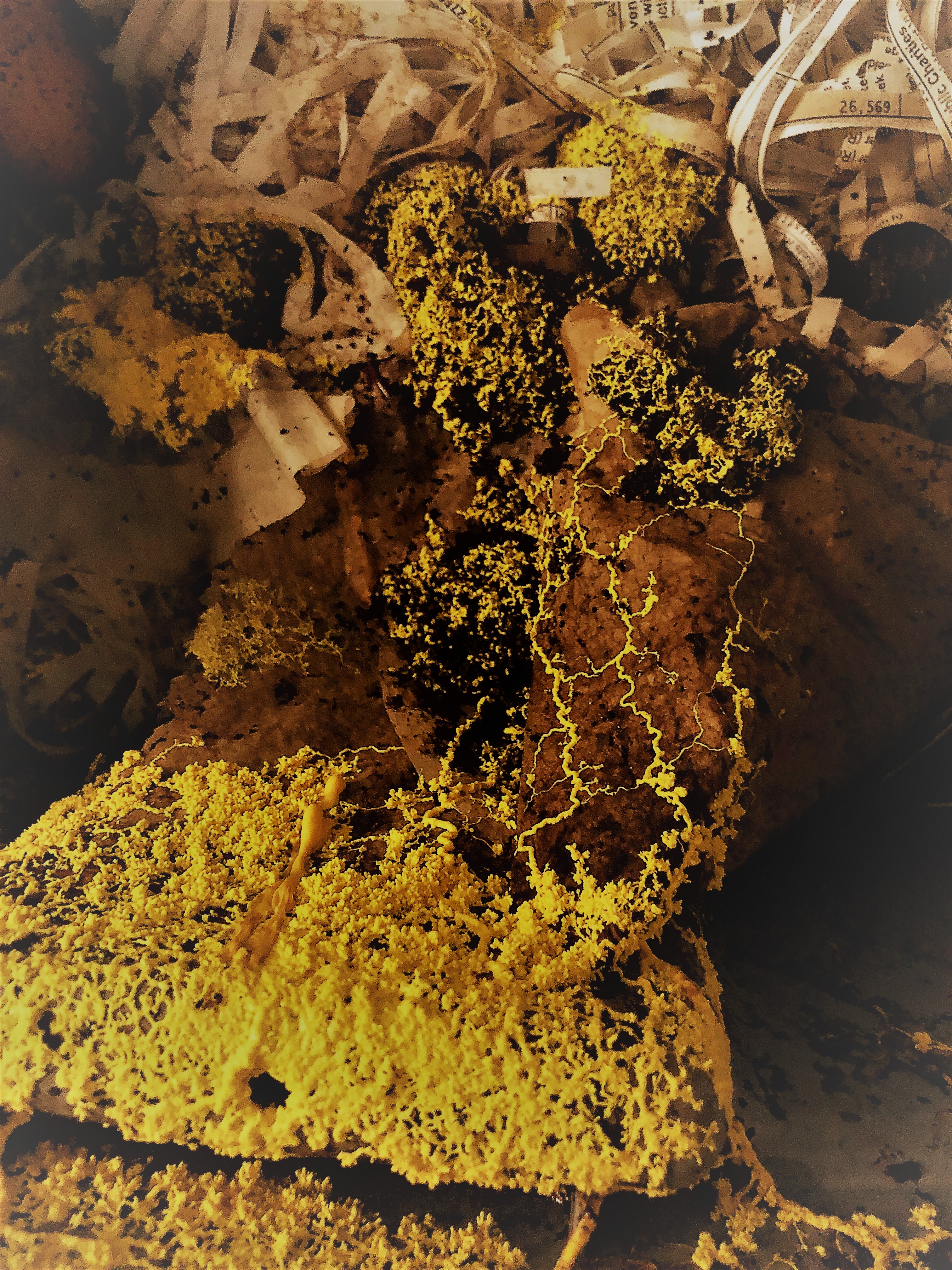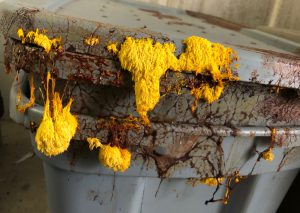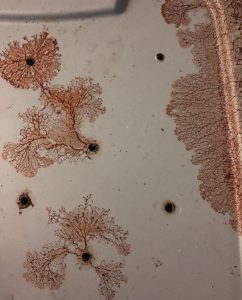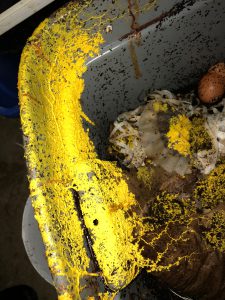
The plasmodium of Fuligo septica slime mold consuming bacteria and fungi inside the office worm bin. Photo by Molly Jameson.
Just when we thought we had our Leon County Extension vermicompost bins all figured out for recycling office food waste with the aid of worms…aliens invaded. I instinctively started looking all over for my “Ghostbusters” proton gun and backpack – but when they didn’t turn up, I decided to retreat and do a little research.
A mesmerizing bright yellow substance had taken over the entire top of the office worm bin, and when the lid was lifted, the yellow ooze was streaming down the inside of the lid and into the bin. Long, squiggly zig zags seemed to be engulfing nearly all the contents within the worm bin.
Unlike Ray Stantz’s reaction when he first meets Slimer devouring the room-service leftovers in the hotel hallway in the original “Ghostbusters,” we were all a little taken aback by our surprise intruder.
“Oh my! Will it kill our worms? Is it toxic? Where did it come from?”
Turns out our slimy yellow visitor was Fuligo septica; a species otherwise known as – and here’s hoping you’re not eating – dog vomit slime mold. A fitting name, indeed. To our amazement, Fuligo septica is not actually a mold (aka: fungus). Nor is it a plant, animal, or bacteria. It is actually a plastid, in the kingdom Protista and class Myxogastria, whose wind- or insect-spread spores converge and divide into a singular giant cell containing millions of nuclei, known as a plasmodium. These individuals come together to form a larger plasmodium and move as a mass of protoplasm, about a millimeter per hour, to feed on microorganisms living in decaying plant material.
I know what you’re thinking…this smattering of scientific terms has you right back in high school science class, and you’re feeling a bit woozy. But really – who needs science fiction movies like “Ghostbusters” when we have scientifically-explained neon slime molds all around us?

After a few days, Fuligo septica transforms into a pillow-like fruiting body in preparation for spore dispersal. Photo by Molly Jameson.
Besides the potential of Fuligo septica spores to be an allergen to those who are susceptible, this surprisingly common slime mold is not toxic to people, plants, or animals. It can be found on rotting bark and forest floors in nature – or on wood mulch in urban areas – normally when conditions are moist. The microorganisms the slime mold consumes are mainly bacteria and fungi, which are also very much present in the decaying food scraps and coffee grounds within a worm bin. And although Fuligo septica is harmless to people, it needs to watch out for us, as it is actually edible! Appropriately, another name for dog vomit slime mold is scrambled egg slime, as indigenous people in some areas of Mexico have collected the mold and scrambled it like eggs. Breakfast anyone?
Although real-life slime molds give Slimer a run for his money, the plasmodium blob of Fuligo septica will not stay its striking yellow amorphous shape for long. After a few days, it transforms into a pillow-like aethalium – a spore-bearing fruiting body like that of a mushroom – then degrades, darkens to a pinkish tan color, and finally releases its spores to start anew when conditions are right.

As the slime mold degrades, it darkens to a pinkish tan color, and releases its spores into the air. Photo by Molly Jameson.
Slime molds have stood the test of time, as analyses of their DNA has revealed they’ve been on Earth approximately a billion years! For reference, that’s hundreds of millions of years before plants or animals. And it’s a good thing Fuligo septica is here, because some of its characteristics has shown a lot of potential to be helpful, including as antibiotics, an ability to fight cancer cells, as antimicrobials, and environmental site remediation due to its ability to hyper-accumulate toxic heavy metals, such as zinc, and convert them to inactive forms. Scientists have discovered it’s the same yellow pigment that gives Fuligo septica its striking color that also forms a chelate with the heavy metals.
So, if you’re walking through a forest, down a path of mulch, or tending to your worm bin and come across this eye-catching, bright-yellow blobby creature, let this plasmodium do its thing. Probably better to scramble some actual eggs, lest your guests be squeamish.
- Cool Season Annual Herbs to Plant in December - December 11, 2025
- The Dirt on Compost: Hot and Worm Composting at Home - October 30, 2025
- Fall Gardening Spotlight: Collard Greens - October 3, 2025

